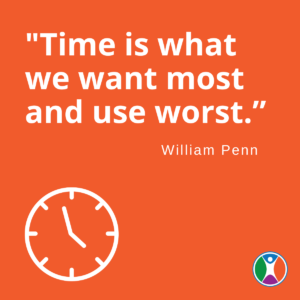“Time is what we want most and use worst.” – William Penn.
We all have the same 24 hours.
While some people use them to achieve amazing results, the rest of us feel like we just don’t have enough to accomplish all we want to do.
Dig a little deeper and you’ll see that the problem isn’t really how much time you have.
It’s how you spend it.

Where is the time going?
We’re not accusing your team of slacking off on social media. In fact, the opposite is probably true: your team is working enormously hard on non-value-added tasks.
Instead of doing the things that will benefit your business, they’re searching for, double checking, or confirming information that they never received or that was only partially communicated.
Some team members may even be working on the same exact tasks – a duplicative, wasted effort.
If you try to find where to save time in everyone’s schedule, you won’t. So, what can you do to discover more time for yourself and your team?
Look at it from a new perspective
You can’t look at mismanaged time on an individual level. Significant time savings aren’t obvious when you’re looking at one person’s 40-hour week. However, you’ll likely see plenty of opportunities if you consider the team’s hours as a whole. If you have a team of ten people, instead of having each person look at their own 40-hour week, you can make the entire group accountable for their collective 400 hours, opening up entirely new possibilities.
- Balance tasks with the team
Let’s say your team can spend time on these four categories:
- administrative
- project
- training
- production/value added
When there are no expectations for how much time should be spent in which category, the time will be spent by default.
It works like a checking account. If you spend more time on projects, training, or administration than expected, it reduces the time spent on value-added work that makes money for the company. Without expectations, your team will likely spend more time on non-value-added tasks than on the work that generates the revenue to pay for it. For example, people will attend unnecessary meetings or work on special requests that aren’t in accordance with the expectations of your organization.
Team planning lets you know if you’re allocating time in alignment with your expectations. The Dorsey Group has a team planning worksheet that helps organizations manage and control the productivity of their teams’ hours. This tool ensures that the amount of time allocated to different tasks meets your expectations and is aligned with your goals and indicators.
- Set priorities
You’ve probably already created your yearly goals, but when was the last time you actually looked at them? Or used them to guide how much time gets allotted to certain tasks each week? Pull them out of the drawer beside you because we’re going to talk strategy deployment.
When you use your goals on a daily and weekly basis, you’ll be able to identify the smaller tasks and milestones that must be accomplished and allocate the appropriate amount of time your team needs to get them done.
Once you’re able to determine which tasks have the biggest potential gains, you’ll be able to delegate those mission-critical tasks to your team and set expectations for how much time should be spent there versus other types of work.
- Manage interruptions
Your team is full of hard-working people. When someone is asked to get something done, they do it. While most of us would believe that’s a good thing, the truth is that it actually depletes the amount of time they have to spend on the mission-critical tasks you’ve established.
Instead of asking them to say no, which can be difficult because of their work ethic or their relationships with their colleagues, assign one person on the team to take the role of coordinator. He or she is the only person who can give members of that team an assignment.
When someone asks a team member to complete a task, he or she can refer the requestor to their coordinator instead of just saying no.
The coordinator must be a team member because only someone on the team will truly understand the team’s goals, priorities and time budget. He or she will be able to assess the importance of a request based on the team’s priorities and assign it to someone who is able to perform it with minimal impact to the team’s results.
There will probably be more requests for your time and activities than you have time. When you know how much time you have allocated, you’re able to work on the priorities and let people know what’s not going to be accomplished. You can say “we simply don’t have the time in our checking account” and they’ll be able to make arrangements to get it accomplished another way.
- Understand and stay focused on priorities
Doing something because it’s always been done that way is a poor excuse for doing anything. Schedule time to evaluate your team’s current processes and determine what’s working and what isn’t. Streamlining your processes will allow your team to focus on the mission-critical, value-added, profit-generating tasks that actually produce the results you wanted when you first set your goals.
The time is there, you just have to know how to look for it.
These ideas aren’t true for just one industry or type of business. They are universal and can be applied in all industries by businesses of all shapes and sizes. Instead of trying to find where time is being wasted on an individual level, empower your team to take control of how they spend their time. When they’re able to consolidate their efforts, they’ll be able to eliminate the non-value-added tasks they work on now to improve their performance and produce incredible results.
The Dorsey Group can help unleash your team’s potential and power peak performance. For more information, contact us at www.TheDorseyGroup.org or (954) 629-5774.

